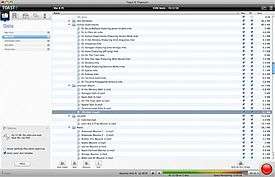Roxio Toast
Roxio Toast is an optical disc authoring and media conversion software application for Mac OS X. Its name is a play on the word burn, a term used for the writing of information onto a disc through the use of a laser.
 | |
 Roxio Toast version 9 in data pane | |
| Developer(s) | Roxio |
|---|---|
| Stable release | 18 [±] |
| Preview release | n/a (n/a) [±] |
| Operating system | Mac OS X |
| Type | Optical disc authoring software |
| License | Proprietary commercial software |
| Website | Roxio Toast |
Discs can be burned directly through Mac OS X, but Toast provides added control over the process as well as extra features, including file recovery for damaged discs, cataloging and tracking of files burned to disc. It also provides support for audio and video formats that Quicktime does not support, such as FLAC and Ogg.
Toast was developed by Dr. Markus Fest and his company Miles Software GmbH and distributed by Astarte. In 1997, the product was purchased by Adaptec, and later transferred to Roxio (then a division of Adaptec).[1]
Version history
- Version 4 (released by Adaptec)
- System 7.5.1 or later (OS 8.6 or later is required for USB support)
- last release that can run on System 7 with a 68k CPU.
- Version 7 [2]
- Macintosh computer with a PowerPC G4 processor or higher
- Mac OS X v10.3.9 or higher
- Version 8 [3]
- PowerPC G4, G5, or Intel Core processor.
- Mac OS X v10.4.8 or later.
- Version 9 [4]
- PowerPC G4, G5, or Intel processor.
- Mac OS X v10.4.x and Mac OS X v10.5.x
- Version 10 [5]
- PowerPC G4, G5, or Intel processor.
- Mac OS X v10.5.x
- Version 11
- System requirements:.[6]
- Mac® computer with an Intel® processor
- 1 GB RAM (2 GB RAM recommended for Pro)
- Mac OS X 10.5, 10.6, 10.7, 10.8, 10.9
- Version 11 represented a completely redesign interface in an effort to modernize the product. The modernization team included: Patrick Nugent, James Manning and Matthew McClendon.
- System requirements:.[6]
- Version 15
- System requirements:[7]
- Mac® computer with an Intel® processor
- 1 GB RAM (2 GB RAM recommended for Pro)
- Mac OS X 10.7, 10.9, 10.10, 10.11, Partial functionality on Mac OS 10.8
- System requirements:[7]
References
- Review: Toast 8 Titanium
- "Toast 7 System Requirements".
- "Toast 8 System Requirements".
- "System Requirements for Toast 9 Titanium".
- "Toast 10 Titanium System Requirements".
- "Toast 11 system requirements". Archived from the original on 18 May 2013. Retrieved 5 June 2013. (Available also on the Corel support website.)
- "Toast 15 system requirements". Retrieved 27 July 2016.